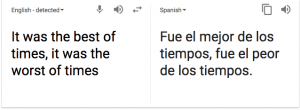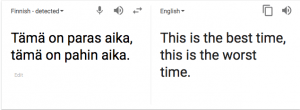For this artwork, I chose to focus on the appropriation of technology. We use technology to assist us in our work and so design this technology to be used in a certain way. For example, Google Translate is intended to be used to simply translate text from one language to another. This is typically used in situations where we need to interact with those who do not speak the same language as us, so that we may communicate with them. I was inspired by the works of appropriation from the Dada movement, especially works like Raoul Hausmann’s Mechanischer Kopf (Der Geist unserer Zeit). In this piece, Hausmann adorns a wooden head with a variety of objects that have specific purposes, such as a ruler used for measuring. This use of objects with specific, everyday purposes to create art is what inspired me to use Google Translate in a way that was not intended by its designers.
This work is a game in which one player chooses an English sentence or phrase with a certain theme and translates it between various other languages, about 10 or so at least, and then translates the sentence back to English. Because certain words or phrases do not translate perfectly from one language to another, the original sentence becomes modified in the translation. The other players must then look at this translation and write down what they think the original sentence was. The player that comes the closest to the original sentence wins the round. This game can be played for as many or as few rounds as the players desire.
In the original iteration of the game, there was no theme for the sentences, so it was difficult to discern what the original sentences might have been referencing. With a theme, such as famous first lines of books, the players at least can draw from a specific set of knowledge, rather than randomly guessing.

The original sentence

The modified sentence
